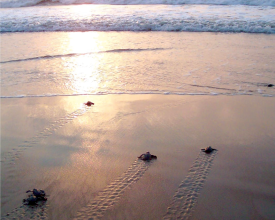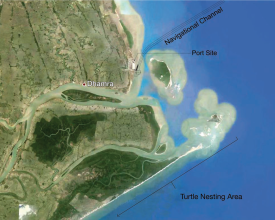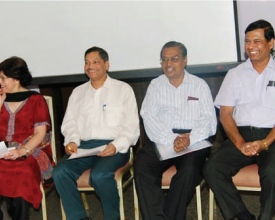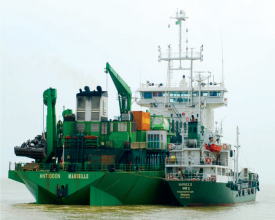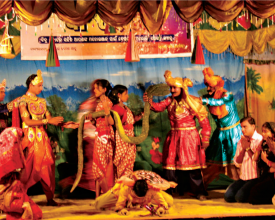
Assurer la conservation des tortues olivâtres : une étude de cas sur la manière dont le développement et la conservation peuvent coexister
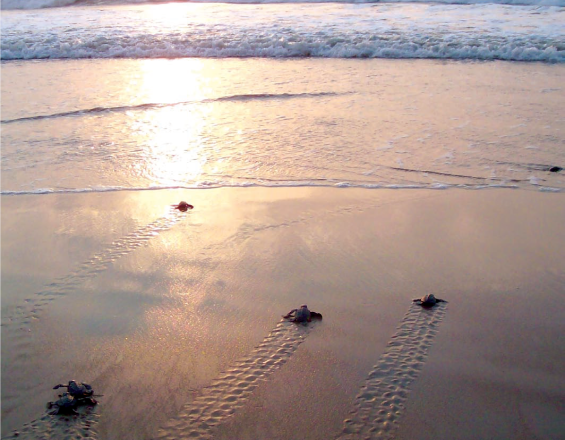
L'histoire du port de Dhamra est celle d'une grande entreprise et d'une organisation mondiale de protection de l'environnement qui ont travaillé ensemble pour s'assurer que la construction d'un grand port industriel en eau profonde en Inde ne nuirait pas à une importante population de tortues de mer menacées d'extinction. Du point de vue du développement, le site était parfait. Cependant, du point de vue de la conservation, des questions se posaient quant à son emplacement à proximité de l'un des plus grands sites de nidification de la tortue olivâtre, protégé par la loi indienne. La collaboration entre DPCL-Dhamra Port Company Limited (à l'époque une coentreprise entre Tata Steel et L&T) et l'UICN montre que le développement et la conservation peuvent coexister et qu'il existe des moyens de se développer d'une manière responsable qui réponde à la fois aux besoins des personnes et à ceux de la nature. Les enseignements tirés de ce partenariat peuvent être appliqués à d'autres projets qui auront des résultats positifs similaires pour les populations et la nature.
Contexte
Défis à relever
Le principal défi de ce projet était d'assurer le succès et la continuité des mesures de sauvegarde visant à protéger les tortues de l'impact sévère de la construction du port et des activités portuaires à long terme qui s'ensuivent. Cependant, il y a eu d'autres défis liés au changement de comportement souhaité. Il s'agit notamment de
- la résistance des acteurs concernés au projet ; et
- le risque de réputation pour les principales parties prenantes.
Pour assurer la protection des populations d'olivâtres à long terme, il était également important de sensibiliser les communautés à l'importance des tortues, notamment en modifiant les pratiques de pêche des communautés qui contribuaient à la mortalité des tortues.
Emplacement
Traiter
Résumé du processus
Les trois composantes du projet ont permis de trouver une solution holistique au problème de l'équilibre entre le développement et la conservation. Bien que chaque bloc ait abordé un aspect différent du projet, la combinaison de tous ces éléments a contribué à consolider la confiance mutuelle et la collaboration entre les parties prenantes et les acteurs, permettant l'engagement, le dialogue et la compréhension, tant pour les résultats à court terme que pour la durabilité à long terme.
Blocs de construction
Des partenariats solides et une communication ouverte
Le secteur privé est généralement décrit comme étant aveugle aux questions environnementales. En réalité, le secteur privé est fortement investi dans la biodiversité. Le projet a permis aux entreprises d'approfondir leur compréhension des questions environnementales et de prendre l'habitude de penser au-delà des résultats. De manière moins évidente, c'est une occasion pour les spécialistes de l'environnement d'approfondir leur compréhension de la dynamique des entreprises et du développement et d'apprendre à inclure l'analyse des résultats dans leurs propres évaluations.
Facteurs favorables
Des pratiques de communication solides sont allées de pair avec le partenariat. En raison de la sensibilité de la question parmi les organisations environnementales et d'autres secteurs, l'approche du projet a consisté à rendre les informations transparentes et accessibles au public. Les partenaires ont décrit très clairement ce qu'ils faisaient et ce qu'ils ne faisaient pas - et pourquoi. Les informations ont été diffusées par le biais de fiches d'information et du site web du projet, ainsi qu'à l'occasion de discussions et de réunions publiques.
Leçon apprise
Un certain nombre d'autres efforts ont été déployés pour s'assurer que les informations circulaient librement entre les principales parties prenantes. Par exemple, début 2009, l'UICN a organisé un atelier technique consultatif sur le port de Dhamra à Bhubaneswar, Odisha, suivi d'une visite du site portuaire. Ce forum interactif a rassemblé des représentants du gouvernement, du secteur privé, des scientifiques locaux et internationaux de premier plan, des experts techniques, des universitaires et des représentants des communautés locales. Le travail avec la presse a permis de diffuser les messages au niveau national. Ces efforts ont encouragé la participation et contribué à dissiper la confusion.
Science et expertise technique
Le dragage, reconnu comme une menace sérieuse pour les tortues marines, a été identifié par l'UICN comme une priorité. L'UICN, avec des experts du groupe de spécialistes des tortues marines de la Commission de survie des espèces, a conçu et développé un protocole de dragage à suivre pendant les opérations portuaires. Il s'agissait notamment d'installer des déflecteurs de tortues sur toutes les têtes de drague afin de s'assurer que les tortues n'étaient pas entraînées dans la drague. Des observateurs formés ont été affectés à toutes les dragues pour surveiller ce processus. Ces observateurs vérifient 24 heures sur 24 et 7 jours sur 7 les grilles des tuyaux d'entrée et de débordement. Ces mesures (déflecteurs, écrans et observateurs humains) ont été mises en place pour s'assurer que le dragage était "respectueux des tortues". Ces mesures sont les premières à avoir été mises en place dans l'histoire des activités de dragage en Inde.
L'éclairage a été la deuxième menace majeure identifiée car on sait que l'éblouissement excessif distrait les jeunes tortues qui se dirigent instinctivement vers les zones très éclairées et s'éloignent de la mer. Les experts de la Commission de l'UICN ont donc fourni des lignes directrices spécifiques pour le plan d'éclairage du port, qui a été adopté par les autorités portuaires. L'UICN a également aidé Tata Steel à identifier la bonne conception de ces éclairages. Aujourd'hui, le port de Dhamra est le premier et le seul port en Inde à avoir installé un éclairage "respectueux des tortues".
Facteurs favorables
L'UICN a aidé DPCL à élaborer un plan de gestion de l'environnement (PGE). Ce plan était scientifiquement solide et pratiquement applicable, allant au-delà des exigences légales existantes. Plus important encore, le PGE a été conçu de telle sorte qu'il fasse partie intégrante des procédures opérationnelles standard (POS) de DPCL. C'est ce qui le différencie des autres PGE.
Leçon apprise
Les infrastructures à grande échelle peuvent être conçues de manière à intégrer avec succès des considérations relatives à la biodiversité.
Sensibilisation de la communauté et gouvernance
L'UICN s'est engagée dans le projet du port de Dhamra parce qu'elle craignait que le port ne nuise aux tortues olivâtres. Cependant, en creusant les problèmes, l'UICN a appris que le taux de mortalité des tortues avait déjà augmenté de façon spectaculaire. Un rapport préparé par le Wildlife Institute of India indique que la mortalité des tortues est passée de quelques milliers par an au début des années 1980 à plus de 10 000 au milieu des années 1990. La pêche mécanisée au chalut et la pêche au filet maillant sont considérées comme responsables de ces mortalités.
La communauté locale était peu sensibilisée à la valeur des tortues. Pour y remédier, l'équipe de l'UICN s'est engagée dans des activités de sensibilisation de la communauté, y compris des programmes éducatifs créatifs, ainsi que des activités de sensibilisation traditionnelles. DPCL a également mis en place un centre de formation communautaire afin que les villageois puissent acquérir de nouvelles compétences.
L'UICN a également constaté que l'utilisation de dispositifs d'exclusion des tortues (TED) pourrait contribuer à réduire la mortalité des tortues due à la pêche au chalut, l'un des principaux problèmes de la région. Ces dispositifs n'étaient pas nouveaux pour les pêcheurs de la région de Dhamra - des ONG et des scientifiques indiens les avaient testés avec les pêcheurs par le passé - mais ils n'étaient pas utilisés. L'équipe du projet DPCL de l'UICN a longuement consulté les responsables des coopératives de pêche locales et les communautés afin de mieux comprendre les problèmes.
Facteurs favorables
Un atelier de formation a été organisé et un certain nombre d'essais pratiques des TED pour les pêcheurs de la région ont été facilités. Changer les pratiques des communautés locales de pêcheurs reste une priorité majeure, mais nécessitera des programmes d'éducation à long terme combinés à des solutions politiques.
Leçon apprise
Le dernier obstacle à surmonter dans cette arène publique était la gouvernance. Au début, les autorités locales semblaient plus préoccupées par les droits des pêcheurs que par la sécurité des tortues. Cependant, au fur et à mesure que la compréhension s'est répandue, les agences gouvernementales sont devenues des partenaires qui ont défendu les solutions holistiques à long terme. Des formations sur les moyens de subsistance alternatifs ont été organisées afin d'offrir à la communauté des options génératrices de revenus autres que la pêche.
Impacts
Grâce à ce partenariat et avec l'aide de l'UICN, DPCL a élaboré un plan de gestion de l'environnement (PGE). Ce plan traite des réglementations, de la politique, de la planification, de la mise en œuvre, des opérations et de la gestion, ainsi que de l'assurance et du contrôle de la qualité. Il détaille les procédures nécessaires à la gestion du changement et au développement d'une culture d'entreprise qui donne la priorité à la sécurité, à la protection de l'environnement et à la promotion de relations positives avec les communautés.
Pour financer les recherches et les interventions en cours, un fonds fiduciaire, proposé par l'UICN, est en train d'être créé pour soutenir la conservation à long terme dans la région. Le DCPL et l'UICN ont entamé le processus de création du "Dhamra Conservation Trust". Le Trust se concentrera sur la conservation des tortues le long de la côte d'Odisha, sur l'amélioration de la qualité de vie grâce à des moyens de subsistance alternatifs, sur la promotion des opportunités pour les femmes et sur l'autonomisation des villageois.
À plus grande échelle, le projet a permis aux acteurs du secteur privé, du secteur public et de la société civile de mieux comprendre qu'il est possible de faire beaucoup pour traiter simultanément le développement et l'environnement, de manière durable, en utilisant de bonnes méthodes scientifiques. Les résultats du projet modifient les perceptions, non seulement du côté des entreprises sur la durabilité environnementale, mais aussi du côté des organisations environnementales sur le rôle qu'elles peuvent jouer pour permettre des percées similaires dans les pratiques commerciales durables.
Bénéficiaires
- DPCL
- Tata Steel
- UICN (Union internationale pour la conservation de la nature)
- Pêcheurs et communautés locales
- Population de tortues olivâtres
Objectifs de développement durable
Histoire
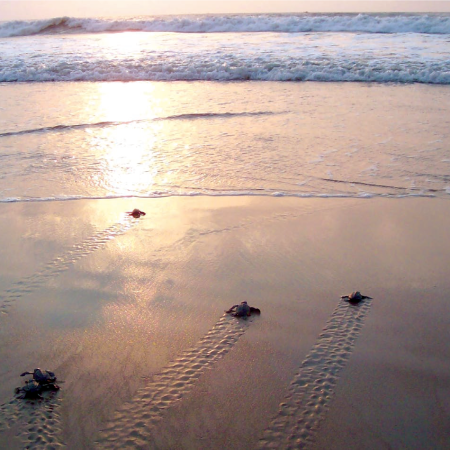
L'histoire du port de Dhamra est une histoire de malentendus, de difficultés techniques et de conflits. Mais c'est aussi l'histoire d'individus déterminés, d'entreprises éclairées, d'approches innovantes et de bénéfices mutuels. En fin de compte, l'histoire s'est bien terminée pour les tortues olivâtres et les habitants de l'Odisha.
En Inde, de nombreuses organisations environnementales se sont opposées au développement du port. Tata Steel a cherché à déterminer si l'infrastructure pouvait être construite sans nuire aux tortues, et a donc demandé conseil à l'UICN.
L'UICN a fait appel à ses experts mondiaux en tortues marines, qui ont travaillé avec l'entreprise pour mettre en œuvre des mesures d'atténuation. La communauté environnementale et les ONG membres de l'UICN ont critiqué l'implication de l'organisation. Ils se demandaient si le port pouvait être construit sans nuire à cette population d'une espèce vulnérable.
Les données internationales montrent que les ports et les tortues peuvent coexister si les procédures opérationnelles standard sont respectées. En mobilisant son réseau international d'experts, l'UICN peut apporter une science objective et un engagement en faveur de la conservation.
Bien que la stratégie sur les entreprises et la biodiversité approuvée par le Conseil de l'UICN impose de travailler avec les industries à "forte empreinte", certains membres de l'UICN ont estimé que l'UICN ne devrait pas s'engager auprès de certaines industries à forte consommation de combustibles fossiles. D'autres ont fait valoir que, si l'on tient compte de la possibilité d'influencer un projet de développement à grande échelle et d'atténuer l'impact sur une espèce, les compromis en valent la peine.
S'appuyant sur les meilleures pratiques mondiales, la communauté scientifique internationale a soutenu cette position et a conclu qu'il était possible d'atténuer les dommages causés à l'environnement. L'UICN est restée un partenaire neutre dans le projet, utilisant la science pour obtenir un résultat optimal. Pour l'UICN, ce projet a été une occasion importante d'apprendre à collaborer avec les entreprises afin d'obtenir les meilleurs résultats pour la nature et les communautés locales.
Les deux organisations ont travaillé ensemble en relevant de nombreux défis pour montrer que le développement et la conservation peuvent coexister et qu'il existe des moyens de se développer de manière responsable en répondant simultanément aux besoins des personnes et de la nature. La confiance établie entre le groupe Tata et l'UICN a conduit à d'autres formes d'engagement, prouvant que la protection de la biodiversité peut être un principe fondamental d'une industrie à forte empreinte.
